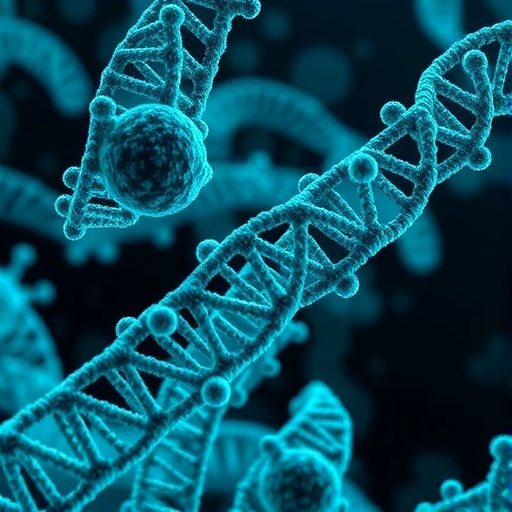
In a groundbreaking leap for molecular immunology, new research has unveiled the enigmatic role of N-glycosylation on small RNAs in preventing immune system overactivation. This discovery not only reshapes our understanding of RNA biology but also illuminates a natural “stealth” mechanism employed by cells to evade innate immune detection. The study, recently published in Nature, reveals that N-glycans attached to glycoRNAs mask an immunostimulatory modification, thus preventing the activation of endosomal RNA sensors that would otherwise trigger inflammatory responses.
For years, glycosylation has been recognized as a pivotal modulator of protein localization and function, influencing everything from cell-cell communication to immune recognition. Unexpectedly, this research identifies that small RNAs themselves undergo N-glycosylation at a unique RNA base, 3-(3-amino-3-carboxypropyl) uridine (acp³U). This finding challenges the traditional dogma that RNA modifications merely Fine-tune RNA stability or translation, instead assigning a critical, previously undiscovered immunomodulatory function to RNA glycosylation.
The team’s experiments reveal that when these N-glycans are enzymatically removed from glycoRNAs isolated from both human and mouse cell cultures as well as from circulating extracellular compartments, a robust innate immune activation ensues. This response is characterized by a surge in type I interferons, molecules central to antiviral defenses and inflammatory pathways. Strikingly, this immune activation relies heavily on Toll-like receptor 3 (TLR3) and Toll-like receptor 7 (TLR7), classical sensors of viral RNA located within the endosomal compartment.
.adsslot_hNZ6B4b2sA{width:728px !important;height:90px !important;}
@media(max-width:1199px){ .adsslot_hNZ6B4b2sA{width:468px !important;height:60px !important;}
}
@media(max-width:767px){ .adsslot_hNZ6B4b2sA{width:320px !important;height:50px !important;}
}
ADVERTISEMENT
Delving deeper, the researchers probed the functional consequences of RNA glycosylation in the context of apoptotic cell clearance, a physiological process crucial for tissue homeostasis. Apoptotic cells expose small glycoRNAs on their surfaces; these N-glycans effectively cloak the immunogenic acp³U modification on the RNA, preventing recognition by efferocytes—specialized phagocytic cells tasked with engulfing dead cells without provoking inflammation. When N-glycans are removed, these apoptotic cells inappropriately activate endosomal RNA sensors, leading to unwarranted inflammatory signaling that could contribute to autoimmune pathogenesis.
Mechanistically, the study establishes that N-glycans act as a biochemical barrier, shielding the hypermodified uracil base acp³U on glycoRNAs from detection by innate immune receptors. The immunostimulatory potential of acp³U becomes unmasked only upon de-N-glycosylation, suggesting a direct interplay between RNA glycosylation status and immune sensor accessibility. This molecular camouflage elegantly explains how glycoRNAs can localize to cellular surfaces and navigate the endosomal environment without precipitating autoinflammatory responses.
A critical validation of this mechanism comes from the genetic deletion of DTWD2, an enzyme responsible for the synthesis of the acp³U modification. Cells lacking DTWD2 fail to activate innate immune signaling in response to de-N-glycosylated RNAs and apoptotic cells, underscoring that acp³U is indispensable for immune recognition in this context. Furthermore, synthetic RNAs engineered to contain acp³U and lacking N-glycans are sufficient to potently stimulate innate immune pathways, confirming the causative role of this RNA base modification in immune activation.
Beyond deepening fundamental RNA biology, these findings have profound implications for understanding and potentially manipulating immune evasion mechanisms. The discovery of RNA N-glycosylation as an immunological “off switch” that prevents self-RNA from triggering innate sensors reveals a molecular safeguard against autoimmune inflammation. Dysregulation of this process may underlie pathologies where apoptosis and immune clearance balance is disturbed, such as systemic lupus erythematosus and other chronic inflammatory diseases.
The existence of glycoRNAs on cell surfaces and in extracellular compartments adds a new layer of complexity to the landscape of glycosylation and innate immunity. Not only proteins but also small RNAs are subject to sophisticated post-transcriptional modifications that dictate their immunological fate. This paradigm shift forces a reconsideration of how RNA modifications and glycosylation collectively shape host defense and self-tolerance.
From a therapeutic perspective, the pathway identified offers exciting avenues for intervention. Targeting the enzymatic machinery responsible for RNA glycosylation or the recognition of acp³U-modified RNA could yield novel strategies to modulate immune responses. For instance, suppressing aberrant immune activation in autoimmunity or enhancing antiviral immunity through controlled exposure of acp³U-containing RNAs might become feasible.
Moreover, the involvement of Toll-like receptors 3 and 7 situates this glycoRNA-centric mechanism in the broader context of viral sensing and innate immune surveillance. Since these receptors detect viral RNA patterns, the masking of endogenous RNA signatures by N-glycans prevents the immune system from mistaking self for non-self. This has striking evolutionary and biomedical relevance, highlighting a refined molecular interplay between host and pathogen signals.
In summary, this pioneering research delineates a previously unappreciated role of RNA N-glycosylation in immune regulation. By concealing an immunogenic modified base, glycoRNAs evade innate immune detection and facilitate silent apoptotic cell clearance, preserving tissue homeostasis. This advance not only expands the known functions of glycosylation and RNA modifications but also sets the stage for novel insights into immunity, inflammation, and potential therapeutic innovation.
The convergence of RNA biology, glycobiology, and immunology exemplified in this study underscores the multidimensional nature of cellular regulation. Future research will undoubtedly explore the full repertoire of glycoRNA modifications, their enzymatic regulators, and their impact across diverse physiological and pathological contexts. This breakthrough reinvigorates the quest to understand how chemical modifications sculpt biomolecule function and immune interactions at the most fundamental levels.
Subject of Research: N-glycosylation of small RNAs and its role in innate immune evasion and apoptotic cell clearance.
Article Title: RNA N-glycosylation enables immune evasion and homeostatic efferocytosis.
Article References:
Graziano, V.R., Porat, J., Ah Kioon, M.D. et al. RNA N-glycosylation enables immune evasion and homeostatic efferocytosis. Nature (2025). https://doi.org/10.1038/s41586-025-09310-6
Image Credits: AI Generated
Tags: acp³U RNA base significanceantiviral defenses and immune responsesendosomal RNA sensorsglycoRNAs and immune modulationglycosylation in molecular immunologyimmune system evasion mechanismsinflammatory response regulationinnate immune activation pathwaysN-glycans and immune detectionNature publication on RNA biologyRNA N-glycosylationsmall RNA modifications





